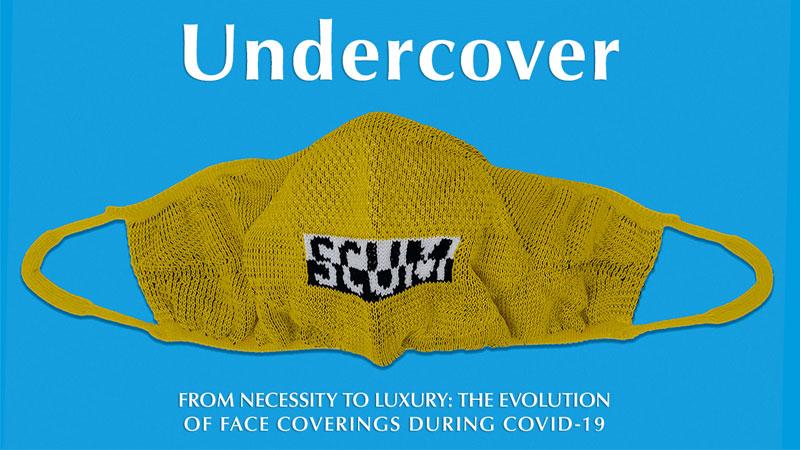Today the Westminster Menswear Archive at the University of Westminster announces ‘Undercover – From Necessity to Luxury: The Evolution of Face Coverings during COVID-19’, a major new exhibition revealing how face coverings have evolved in response to COVID-19 over the last 12 months.

Opening on 11th May 2021, one year on from when the UK government first advised people to wear face coverings in enclosed public spaces, the exhibition will explore how masks have evolved from being a functional PPE object in short supply, to becoming an everyday object worn by millions. The simple cloth face covering, which appears to be an unassuming and uncomplicated object, has quickly become a symbolic and contentious artefact.
The exhibition will present 52 unique face covers arranged in chronological order. It will examine how rapidly the fashion industry adapted production, manufacturing, and online marketing to meet changing consumer demands. Brands responded quickly to support the global effort to produce PPE for medical personnel. As masks became mandatory, this shifted to labels developing and manufacturing face coverings for their own customers.
It will explore how these ordinary objects have been transformed from their medical origins to become a highly desirable fashion accessory produced by companies ranging from BoohooMAN to Louis Vuitton. While these masks appear to be non-gendered, their design, marketing, and wearing reveal long-running narratives within menswear concerned with ideas of protection, risk, and masculinity.
The exhibition features examples from Adidas, Balenciaga, BoohooMAN, Burberry, C.P. Company, Fakescum, Ahluwalia, Liam Hodges, Mulberry, Raeburn, Christopher Kane, Master-piece, Huntsman, JW Anderson, Levi's, Liberty, Louis Vuitton, Manchester City FC, New & Lingwood, Off-White, Paul & Shark, Paul Smith, Sunspel, Turnbull & Asser, Vivienne Westwood, and WAWWA.
Alongside the main exhibition will be a photographic presentation titled: Undercover. From Necessity to Debris: The Pollution of Face Coverings During COVID-19. Featuring 365 photographs taken over the last year of discarded face coverings in the street, it acts as both an archive of highly disposable material culture and as a reflection on the environmental impact of our response to COVID-19. It will be curated digitally as 365 NFT’s (non-fungible tokens) available on OpenSea, the world's largest marketplace for digital goods.
Talking about the exhibition, Professor Andrew Groves, Professor of Fashion Design, said: “The rapidly evolving response by designers, as well as the ephemeral nature of the face covers produced, made this an exciting and challenging exhibition to curate. The objects only tell part of the story, as companies unable to rely on their usual supply chains pivoted their production to meet the unprecedented demand for this new product.
“While a year ago, most masks might have seemed to be similar, over the last 12 months we have seen a divergence as consumers and brands have used their mask as a means of differentiating themselves from the masses. As is often the case with fashion, wealth, status, and access have resulted in this simple object rapidly evolving in terms of materiality, functionality, and marketing. One of the exhibition's earliest masks was created by BoohooMAN in April 2020. It was criticised at the time for profiteering from the pandemic and was later withdrawn. Eight months later, in December 2020, Louis Vuitton was selling a mask cover and matching bandana set for £350.”
Dr Danielle Sprecher, Menswear Curator at the Westminster Menswear Archive, added: “Collecting such a range of face coverings for this exhibition has enabled us to look closely at the different ways that the fashion industry has responded (or not responded) to the advent of this new accessory in the UK. It has been fascinating to track these developments through both online retail and in-store offerings. Due to the nature of the Westminster Menswear Archive we have also been able to look at the historic continuity within menswear design of the use of face coverings. Generous funding from the University of Westminster Arts, Communication and Culture Research Community has meant that we have been able to acquire physical masks for the collection. This means we have been able to create a unique repository to reflect this extraordinary period.”
Learn more about the exhibition on the Westminster Menswear Archive website.
Find out more about Fashion courses at the University of Westminster.


